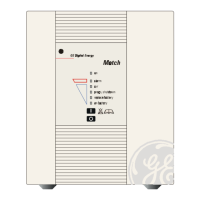LX: OPM_MAE_XXX_2K2_3K0_XGB_V020 4 GE DE Match 2200-3000: user manual 2.0 (GB)
GE Digital Energy
g
Please refer to figure 6.
3.1 Start-up
3.1.1 Start-up, mains available
After first installation the unit will start up automatically, see 2.2 step 4.
After switch-off via the front panel (3.2.5) the unit can be restarted as follows:
1. Press keypad 'I' (16, fig. 6) briefly; LED ‘on’ (already blinking) will illuminate continuously now.
2. The equipment connected to the UPS can now be switched on.
3.1.2 Start-up, mains not available
If the mains input is absent (power cord not connected, or mains failure):
1. Press keypad 'I' briefly, and then
2. Press keypad 'I' during 5 seconds until the buzzer sounds.
The LEDs 'on' and 'on battery' (15, fig. 6) will illuminate. The UPS operates on battery: it
discharges the batteries.
3.2 Use: Normal Operation
3.2.1 Normal operation conditions:
!
the mains supply is present,
!
the UPS is on,
!
the load does not exceed the capacity of the UPS and
!
the operating temperature is below alarm level.
3.2.2 Load indication (fig. 5)
1 During normal operation, press keypad 'I' briefly.
2 Yellow LEDs will blink during 3 seconds, the number is load
dependent (in case of overload LED 'alarm' (11, fig. 6) blinks as
well).
3.2.3 Auto-off (no-load shutdown)
If this function is activated, the UPS will switch off during a mains failure when the load is less
than 5% of the maximum load. In this way unnecessary discharging of the batteries is avoided.
The unit will automatically turn on again when mains power is restored. The default setting of the
no-load shutdown function is: activated. You can change this setting through the RS232 port,
using the UPS configuration tool that came with the unit (CD ROM, see 6.3). Please note that if
the UPS is not connected to the mains, and the battery pack is disconnected from the UPS, the
unit will return to the default setting.
3.2.4 Battery test (see also 3.3.6)
Manual battery test
1. During normal operation, press keypad 'I' and release it immediately after the second beep.
2. The duration of the test is 4 seconds, during which LED ‘on’ blinks.
Automatic battery test
The UPS conducts periodic automatic battery tests:
!
5 hours after manual switch-on
!
30 days from the last battery test, provided that the UPS remains switched on
Deep battery test
A deep battery test, to be initiated through the UPS software via the RS232 port, checks the
actual battery capacity in order to ensure accurate runtime prediction. During a deep battery test
the batteries will be discharged until 'battery low' alarm level. Please note that immediately after a
deep battery test the expected runtime is very short: allow the UPS to recharge its batteries. For
details please refer to the manual of your UPS software.
3.2.5 Switching off
1. Press keypad ‘0’ (17, fig. 6) approx. 1 second, until a beep is heard. LED ‘on’ will start blinking,
indicating that the battery charger remains active.
2. If electric isolation is required, unplug the power cord from the wall outlet.
fig. 5
3 - Operation

